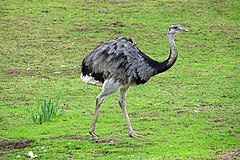Rhea (ptaki)
| Rhea[1] | |||
| Brisson, 1760[2][3] | |||
 Przedstawiciel rodzaju – samiec nandu szarego (R. americana) | |||
| Systematyka | |||
| Domena | |||
|---|---|---|---|
| Królestwo | |||
| Typ | |||
| Podtyp | |||
| Gromada | |||
| Podgromada | |||
| Infragromada | |||
| Rząd | |||
| Rodzina | |||
| Rodzaj |
Rhea | ||
| Typ nomenklatoryczny | |||
|
Struthio americanus Linnaeus, 1758 | |||
| Synonimy | |||
|
| |||
| Rodzaje | |||
| |||
Rhea – rodzaj ptaków z rodziny nandu (Rheidae).
Zasięg występowania
Rodzaj obejmuje nielotne gatunki lądowe, zamieszkujące Amerykę Południową[6].
Charakterystyka
Długość ciała 92,5–140 cm, masa ciała 15–25 kg (wyjątkowo do 40 kg)[7]. Są to szybko biegające nieloty o stosunkowo długich skrzydłach. Długie nogi posiadają trzy palce. Pióra bez zwartych chorągiewek, brak sterówek; dolna część szyi i górna nóg upierzona. Pokrojem przypominają strusie, są jednak od nich mniejsze. Odżywiają się pokarmem mieszanym.
Systematyka
Etymologia
- Rhea: Nazwa „Rhea” została nadana nandu szaremu przez niemieckiego botanika Paula Möhringa w 1752 roku, a wkrótce potem zaakceptowana przez Brissona w 1760 roku. W mitologii greckiej Reja (Rhea lub Rea) (gr. Ῥεία Rheía, Ῥέα Rhéa, łac. Rhea), to córka Uranosa i matka Zeusa, od ῥεω rheō „płynąć”, ponieważ rzeki płyną z Ziemi (γαια gaia „Ziemia”). Znaczenie tego epitetu jest nieznane, chociaż może odzwierciedlać humorystyczne zestawienie Rei jako Wielkiej Matki ze Strusiem, Wielkim Ptakiem, w komedii Arystofanesa „Ornithes”[8].
- Gauria: gr. γαυριαω gauriaō „paradować”[9]. Nowa nazwa dla Rhea Brisson, 1760.
- Pterocnemia: gr. πτερον pteron „pióro”; κνημη knēmē „noga”; nandu plamiste ma upierzoną górną część piszczela w przeciwieństwie do nandu szarego[10]. Gatunek typowy: Rhea darwinii Gould, 1837 = Rhea pennata d’Orbigny, 1834.
Podział systematyczny
R. pennata w niektórych ujęciach systematycznych umieszczany jest w monotypowym rodzaju Pterocnemia[11][12], lecz jest blisko spokrewniony z R. americana i dochodzi między nimi do wypadków krzyżowania się[13]. Do rodzaju należą następujące występujące współcześnie gatunki[14]:
- Rhea americana (Linnaeus, 1758) – nandu szare
- Rhea pennata d’Orbigny, 1834 – nandu plamiste
oraz gatunki wymarłe:
- Rhea mesopotamica (Agnolín & Noriega, 2012)[15]
- Rhea pampeana Moreno & Mercerat, 1891[16]
- Rhea subpampeana Moreno & Mercerat, 1891[16]
Przypisy
- ↑ Rhea, [w:] Integrated Taxonomic Information System (ang.).
- ↑ M.-J. Brisson: Ornithologie, ou, Méthode contenant la division des oiseaux en ordres, sections, genres, especes & leurs variétés: a laquelle on a joint une description exacte de chaque espece, avec les citations des auteurs qui en ont traité, les noms quils leur ont donnés, ceux que leur ont donnés les différentes nations, & les noms vulgaires. Cz. 1. Parisiis: Ad Ripam Augustinorum, apud Cl. Joannem-Baptistam Bauche, bibliopolam, ad Insigne S. Genovesae, & S. Joannis in Deserto, 1760, s. 46. (fr.).
- ↑ M.-J. Brisson: Ornithologie, ou, Méthode contenant la division des oiseaux en ordres, sections, genres, especes & leurs variétés: a laquelle on a joint une description exacte de chaque espece, avec les citations des auteurs qui en ont traité, les noms quils leur ont donnés, ceux que leur ont donnés les différentes nations, & les noms vulgaires. Cz. 5. Parisiis: Ad Ripam Augustinorum, apud Cl. Joannem-Baptistam Bauche, bibliopolam, ad Insigne S. Genovesae, & S. Joannis in Deserto, 1760, s. 8. (fr.).
- ↑ G.J. Billberg: Synopsis Faunae Scandinaviae. T. 1. Cz. 2: Aves. Holmiae: Ex officina typogr. Caroli Deleen, 1828, s. tab. A. (łac.).
- ↑ G.R. Gray: Hand-list of genera and species of birds: distinguishing those contained in the British Museum. Cz. 3: Struthiones, Grallae, and Anseres with Indices of Generic and Specific Name. Londyn: printed by order of the Trustees, 1871, s. 2. (ang.).
- ↑ F. Gill, D. Donsker & P. Rasmussen (redaktorzy): Ratites: Ostrich to Tinamous. IOC World Bird List: Version 11.2. [dostęp 2021-01-12]. (ang.).
- ↑ D.W. Winkler, S.M. Billerman & I.J. Lovette: Rheas (Rheidae), version 1.0. W: S.M. Billerman, B.K. Keeney, P.G. Rodewald & T.S. Schulenberg (redaktorzy): Birds of the World. Ithaca, NY: Cornell Lab of Ornithology, 2021. DOI: 10.2173/bow.rheida1.01. [dostęp 2022-01-12]. (ang.).

- ↑ Rhea, [w:] The Key to Scientific Names, J.A. Jobling (red.), [w:] Birds of the World, S.M. Billerman et al. (red.), Cornell Lab of Ornithology, Ithaca [dostęp 2022-01-12] (ang.).
- ↑ Gauria, [w:] The Key to Scientific Names, J.A. Jobling (red.), [w:] Birds of the World, S.M. Billerman et al. (red.), Cornell Lab of Ornithology, Ithaca [dostęp 2022-01-12] (ang.).
- ↑ Pterocnemia, [w:] The Key to Scientific Names, J.A. Jobling (red.), [w:] Birds of the World, S.M. Billerman et al. (red.), Cornell Lab of Ornithology, Ithaca [dostęp 2022-01-12] (ang.).
- ↑ A. Folch: Family Struthionidae (Ostrich). W: J. del Hoyo, A. Elliott & J. Sargatal: Handbook of the Birds of the World. Cz. 1: Ostrich to Ducks. Barcelona: Lynx Edicions, 1992, s. 89. ISBN 84-87334-10-5. (ang.).
- ↑ E.C. Dickinson: The Howard and Moore complete checklist of the birds of the World, Revised and enlarged 3rd Edition. Londyn: Christopher Helm, 2003. ISBN 978-0-691-11701-0. (ang.).
- ↑ Frédéric Delsuc, Mariella Superina, Guillermo Ferraris, Marie-Ka Tilak, Emmanuel J. P. Douzery. Molecular evidence for hybridisation between the two living species of South American ratites: potential conservation implications. „Conservation Genetics”. 8 (2), s. 503-507, 2007. (ang.).
- ↑ Systematyka i nazwy polskie za: P. Mielczarek & M. Kuziemko: Rząd: Rheiformes Forbes, 1884 - nandu (wersja: 2015-08-29). [w:] Kompletna lista ptaków świata [on-line]. Instytut Nauk o Środowisku Uniwersytetu Jagiellońskiego. [dostęp 2021-01-12].
- ↑ F.L. Agnolín & J.I. Noriega. Una nueva especie de ñandú (Aves: Rheidae) del Mioceno tardío de la Mesopotamia Argentina. „Ameghiniana”. 49 (2), s. 239, 2012. (hiszp.).
- ↑ a b F.P. Moreno & A. Mercerat. Enumeración sistematica de las especies. „Anales del Museo de La Plata”. Paleontología argentina. 1, s. 27, 1891. (hiszp.).
